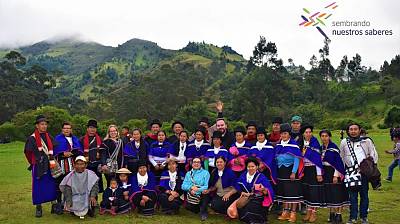The cultural heritage of indigenous people is at risk and today’s pandemic makes it very difficult for them to safeguard it. But we want to share our experience from working with six indigenous groups, out of the more than 107 groups recognised by the Colombian government, to show how the safeguarding and strengthening of their cultural heritage has contributed to their cultural sustainability, as they have told us in recent communications.
Since 2018, the British Council has been implementing in Colombia the Programme Cultural Heritage for Inclusive Growth (CH4IG), which is a joint work with the Misak, Piaroa, Puinave, Ette Ennaka, Cuiba and Yaruro indigenous peoples, each of them located in different regions of the country.
This programme has set out to strengthen the diverse kinds of practices that are part of their cultural heritage, seeking with this to safeguard the traditional indigenous ways of life and worldviews, and to work with them in ways to make cultural heritage useful for their well-being.
Cultural heritage is understood in a holistic way by CH4IG, as the set of manifestations that are part of the indigenous groups’ collective identity, rooted in their own and unique ways in which individuals relate to each other, with their territories and with other societies and cultures in general.
Indigenous peoples in Colombia have been exposed to different kinds of physical and cultural threats, putting them and their traditional knowledge at risk and leading to the gradual disappearance of their own cultural practices, with an increasing dependence on foreign market economies.
The CH4IG programme has been delivered for more than a year and a half and has concluded its pilot phase with different outcomes with each indigenous group. We have work on strengthening traditional agricultural techniques, artisanal making-processes, increase knowledge of territorial and cultural sites, traditional medicine, wood carving of musical instruments, recovering tales and histories about their origins and traditions, rituals, among others.
This process has allowed them to understand the practical value of revitalizing their own culture, as well as a first step in order to cut unfair dependencies on foreign markets.
Seeking greater indigenous autonomy through the use of cultural heritage, we are having the first outcomes of the project that in this moment, are proving to be very important for indigenous groups as they are now in self-isolation expecting not to be infected by the virus, which could be devastating for them.
We can highlight some of the actions that are helping them to face this situation without putting at risk their cultural heritage, and instead reinforcing it.
This is what we know so far by working for them:
- Misak elders are teaching traditional agricultural techniques to young generations so they can survive with their own products and by doing so, they are also strengthening their traditional recipes.
- The Piaroa have continued their work and research with recovering traditional seeds in experimental orchids that is also helping them to strengthen their traditional recipes. In doing so, they don’t need to travel to the nearest town and can avoid being infected.
- Because we had work on recovering and strengthening the Ette Ennaka people traditional medicine they are now looking to deliver the same methodologies to recover their knowledge around traditional agricultural techniques so that they can face the new world without putting themselves at risk of buying food in the nearest towns.
- The Yaruro people have continued to work on their research of how to grow Moriche Palm trees, which is important so that they can feed with it and also build houses with its wood and make crafts to sell in the future. The Yaruro people also researched about their traditional stories related to the moriche palms and the myths related to it.
- The Puinave people can make now their own utensils like sifters, cassava graters, benches or seats, baskets, pots among others, and they don’t have to travel to the nearest town.
Les désignations employées et la présentation des textes et des documents référencés dans cette plateforme n'impliquent de la part de l'UNESCO aucune prise de position quant au statut juridique des pays, territoires, villes ou zones, ou de leurs autorités, ni quant au tracé de leurs frontières ou limites.
